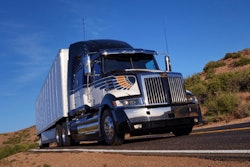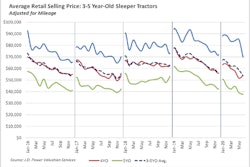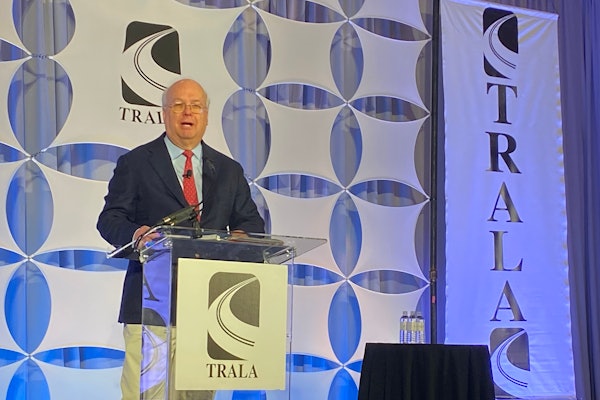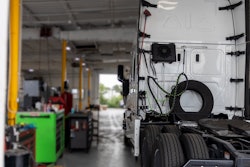
Revenues in the quarter were $1.7 billion, down 45 percent from third quarter 2019, and core (Class 6-8 trucks and buses in the United States and Canada) charge outs were down 53 percent. The decrease was primarily driven by the impact of COVID-19, as well as prior year comparable quarter results that were near the peak of the prior industry cycle, Navistar reports.
Third quarter 2020 EBITDA was $73 million, compared with $281 million in third quarter 2019. Adjusted EBITDA in third quarter 2020 was $104 million versus $266 million a year ago. Adjusted net income for the quarter was a loss of $8 million compared with income of $147 million in the third quarter last year.
Navistar finished third quarter 2020 with $1.65 billion in consolidated cash, cash equivalents and marketable securities, including $1.6 billion in manufacturing cash, cash equivalents and marketable securities.
“Our fiscal third quarter opened during the middle of many stay-at-home orders and ended with sections of the economy beginning to reopen, and our results certainly reflect this,” says Navistar CEO and President Persio Lisboa. “While marketplace uncertainties continue, we are accelerating the pace of progress on our Navistar 4.0 strategy for financial improvement, so we can pull forward its benefits and take full advantage of a stronger industry when it arrives.”
The company’s Navistar 4.0 strategy lays out a plan to increase the company’s EBITDA margins to 12 percent by 2024.
 Navistar CEO and President Persio Lisboa
Navistar CEO and President Persio LisboaDuring the quarter, in addition to naming Lisboa president and CEO and Troy Clarke to the new role of executive chairman, the company made several leadership changes aimed at accelerating the pace of the company’s Navistar 4.0 progress with a focus on opportunities in advanced technologies. These executive appointments included naming Bob Walsh vice president of Emerging Technologies, Strategy and Planning; appointing Friedrich Baumann president of Sales, Marketing and Aftersales; and adding new global responsibilities to the role of Phil Christman, president of Operations.
Earlier this year, the company took several actions to conserve cash and bolster its liquidity in response to the COVID-19 pandemic. These actions have been successful, as the company ended the third quarter with $1.6 billion of manufacturing cash, allowing it to cease its employee salary deferral program on September 1, several months earlier than initially planned. Additionally, actions taken due to the pandemic drove the company’s selling, general and administrative (SG&A) expenses down 29 percent year-over-year, after adjusting for a one-time gain in the prior year. Using learnings gained during COVID-19, the company is pursuing additional sustainable cost savings opportunities.
“We are targeting SG&A costs between 7 percent to 9 percent of revenues,” says Walter Borst, chief financial officer, Navistar. “Our focus has moved from temporary cash conservation actions to sustainable cost savings that support our Navistar 4.0 goals and better position us for profitability at all points in the cycle.”
With its new leadership, learnings from the COVID-19 pandemic and benefits from previous cost conservation actions in place, the company is redirecting more resources to advanced technologies; leading to several announcements during the quarter.
In autonomous, the company announced a strategic partnership with TuSimple to co-develop SAE Level 4 self-driving trucks targeted for production by 2024. The partnership also includes Navistar taking a minority stake in the company.
In connectivity, the company announced strategic partnerships with fleet management solutions providers Samsara and Geotab to allow International customers to seamlessly add their choice of fleet management solutions without the installation of additional vehicle hardware.
In electric, the company’s NEXT eMobility Solutions business unit signed a master services agreement with In-Charge Energy to provide charging infrastructure and consulting services to electric vehicle customers.
The company has been making progress on the construction of its production facility in San Antonio, which is scheduled to open in the spring of 2022. The facility will be capable of building both diesel and fully electric vehicles, and the first vehicle off the line will be an electric truck, entirely built on the main assembly line.
“As a result of the pandemic, we had the opportunity to revisit our investment portfolio and retime noncritical programs, and cancel others,” says Lisboa. “By streamlining our investments, we were able to free up significant capacity, which is being redeployed into advanced technology programs and strategic partnerships that accelerate our pace of progress.”
In third quarter 2020, the truck segment net sales were $1.2 billion, a 50 percent decrease compared with third quarter last year. The year-over-year decrease is primarily due to lower volumes driven by weaker industry conditions resulting in part from the COVID-19 pandemic.
The truck segment incurred a net loss of $22 million in third quarter 2020 compared with a profit of $167 million in third quarter 2019. The year-over-year decrease was a result of lower volumes and a reversal of a non-recurring legal settlement charge in 2019.
The parts segment net sales were $414 million, a 27 percent decrease from third quarter 2019. The decrease is primarily due to lower North America volumes attributable to the COVID-19 impact in the U.S. and Canada and a decrease in Blue Diamond Parts sales.
The parts segments saw a third quarter profit of $97 million, compared with $149 million in third quarter 2019. The decrease is due to the impact of lower sales volumes, partially offset by lower SG&A expenses.
In third quarter 2020, the Global Operations segment net sales decreased 48 percent to $47 million. The decrease was primarily driven by lower volumes in our South America operations triggered by temporary production stoppages related to COVID-19.
The global operation segment recorded a profit of $1 million in the third quarter of 2020 and 2019. The segment benefited from restructuring actions taken earlier this year.
The financial services segment net revenues decreased to $49 million, a 34 percent decrease from third quarter 2019. The decrease was primarily driven by lower average yields due to lower interest rates and lower average finance receivables due to lower volumes.
The financial services segment recorded a profit of $10 million in the quarter, compared with $30 million in third quarter 2019. The decrease was primarily driven by the impact of lower revenues, partially offset by lower interest expense resulting from lower borrowing requirements.
For additional earnings information, CLICK HERE.










